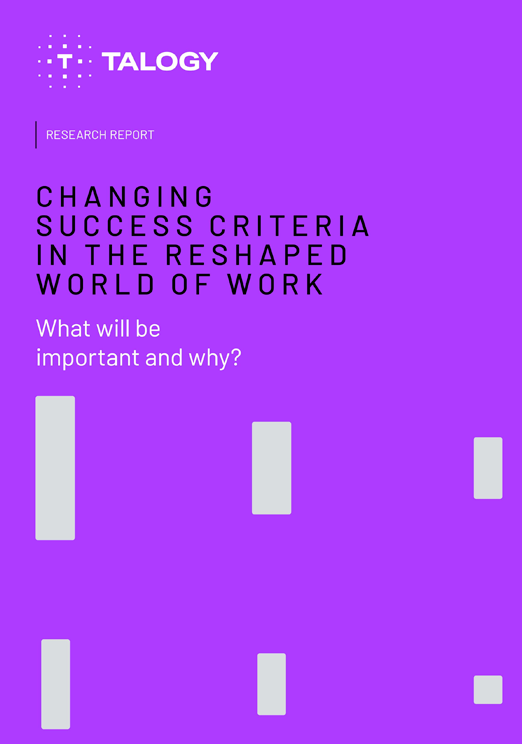Sometimes, there’s no turning back.
Brick-and-mortar stores are never going to put internet retail out of business. Broadcast networks won’t slow the trend of viewers streaming or DVRing shows to watch later. And the business world is not about to shift away from the Big Data revolution.
Why? Because data mining works. That is, if you collect the right data and know how to manipulate it, it yields useful findings. Whether we’re talking about retailers predicting consumers’ future purchases, healthcare providers exploring new approaches to preventative medicine, or credit card companies trying to limit identity theft, data mining has changed our world faster than most could have imagined.
The breakout trend is in talent management. Companies have long kept detailed accounting records, carefully measured materials buying and production output, and counted and recounted inventory until they got it exactly right. Employees? Eh, they show up for work. Some are smart, some are productive, some are lazy. A few steal stuff. What’re ya gonna do?
Hold on a minute! People are every company’s most important asset. They are the company. Why not put the same effort into your most precious resource that you do into determining how many 2x4s to order? Data mining around human capital is more important than shaving a few dollars off production costs. With the right data, a company can transform itself. Here are the five big reasons companies are—or should be—collecting talent data:
- Talent data informs hiring and promotion decisions
This one has been around for a while. Like, decades. If you’ve ever used a personality assessment, you’ve gathered talent data.
A valid personality assessment continues to be the best foundation for talent-related data collection. Its output reveals an applicant’s or employee’s intrinsic motivations and behavioral tendencies, which is the key information needed for determining if that person is right for hiring or promotion.
A classic example is when you have a strong staff member you are considering rewarding with a supervisory role. Often the attributes that make a good individual contributor—conscientiousness, rules following, and task focus—aren’t the same attributes that make a good leader, such as communication skill, decisiveness, and composure. A personality assessment shows you if that person has what it takes to make the transition and where the coaching areas lie.
- Talent data improves enterprise-wide consistency in hiring and development
While the human element will always be the most critical part of the hiring equation, it’s true that everyone harbors unconscious biases. Including managers. This is one of the reasons departments develop their own cultures: managers hire in their own image, managers promote people they like (or who seem non-threatening), and managers’ perspectives on work performance and accountability vary across an organization.
With talent data, companies can limit those biases by looking more objectively at performance, motivation, and potential, which increases consistency both in terms of who is selected for employment and who is deemed qualified for promotion.
- Talent data enables competency modeling
To truly transform a sales force, a service operation, or other broad functional area within your organization, you should develop competency models. This is done by identifying the skills and behaviors that lead to success in a given role or function and then measuring new applicants against the model. In time, your team will be populated by the employees who best align with your success factors, the result being greater productivity and reduced turnover.
The catch: You can’t do a competency model without talent data. Otherwise, it’s merely guesswork subjected to the same biases that influence other decisions.
Not every company has big enough departments (or budgets) to develop competency models on their own, of course, but the good news is that assessment firms like Caliper have built and tested competency models that many small and midsized organizations are already using successfully.
- Talent data helps identify high-potential employees
One of the best and least expensive ways to find top performers is to look at people already on staff. Employees are often underutilized by their organizations, or they have great potential but are in the wrong roles. Meaningful talent data on your existing team members will show you who has untapped leadership potential, project-management attributes, or sales acumen, as well as a quality that is often invisible until you take the step of quantifying it with talent data: learning agility.
The agile learner applies knowledge cross-functionally and adapts effectively in a changing business environment. Which describes the world we work in now, so find that person.
- Talent data builds your People Analytics data lake
This is the biggie. Big Data is expanding like a new universe, and People Analytics will only grow in relevance as we move deeper into the 21st century. If that sounds overly dramatic, remember how overly dramatic it sounded in the 1990s when tech innovators said the internet and related communication technology would radically transform how people shop and consume entertainment. Hundreds of dead retail chains later . . .
More and more organizations are exploring People Analytics, but the resisters still operate under the misconception that analytics is too big, too complicated, and unattainable (i.e., cost prohibitive). In reality, you don’t have to be a Fortune 500 company to play. You just need a way to collect talent data and a platform for mining and sorting it.
More good news! Firms like Caliper can do the data gathering for an organization and provide the mining platform as well, making the endeavor far more affordable than many business leaders realize. And once meaningful data are collected, the doors swing open. Companies can suddenly see their current unrealized potential as well as their talent gaps. They can get a grip on succession planning. Ultimately, they can construct a hiring-and-development strategy that begins to move them in the direction of their ideal state, where they are innovators and industry leaders.
The future is now, as they say. Don’t show up late!

